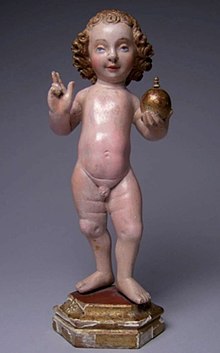

| Infant Jesus of Mechelen l'Enfant Jesus de Malines | |
|---|---|
 | |
| Location | Louvre Museum Department of Sculptures |
| Date | c.1500s |
| Type | Walnut body Polychrome and Gilding Oak wood base |
The Infant Jesus of Mechelen (French: l'Enfant Jésus de Malines) is an unadorned 16th-century wooden image depicting the Child Jesus holding a globus cruciger and imparting a blessing. It is now in the Louvre Museum in Paris, as a typical representative of a type of image produced in considerable numbers in 16th-century Mechelen (Malines, in modern Belgium) and exported all over the Catholic world.
Among Santero collectors, the image is often referred to the "fraternal twin" of the Santo Niño de Cebú, with which it shares crucial similarities on posture, gesture, facial expression, and measurement.[1] In September 2009, the image was privately acquired and now housed in the Louvre Museum under security glass. It is displayed naked without any regalia, accessories or vestments formerly associated with other Child Jesus icons.
In the mid-fifteenth century, workshops in Mechelen (Malines, in modern Belgium) began producing small statuettes of male and female saints,[2] and of the infant Jesus, nude and standing on a socle. The dolls are almost always of walnut, preferably carved from a single block of wood. The guild in Mechelen collaborated with workshops in Brussels, and a client could order a Malines doll with the distinctive polychromy from either.
These (Poupées de Malines) often were part of an altarpiece or an "Enclosed Garden", ("retables, sometimes with painted side panels, the central section filled not only with narrative sculpture, but also with all sorts of trinkets and hand-worked textiles.")[3][4]
Used for private devotion, "Maline dolls" were primarily found in private chapels and beguinages. The Infant Jesus proved particularly popular with convents in the region. Produced in large quantities, they were relatively inexpensive, and became a popular item of export to Spain and Portugal. By the first quarter of the sixteenth century the dolls were ubiquitous throughout Europe.[5]
The image depicts Jesus Christ in his infancy stage. The polychrome materials and characteristics are distinctly from Mechelen, a former part of the Southern Netherlands dating from the early 1500s.[6] The child image alone is made of walnut, carved in a single piece of wood. The present image comprises the following details:
Evidence of European colonial characteristics are present on the statue, such as the gilding of the hair using gold leaf while lead paint and oily potassium is used to the skin, similar to the Encarnacion style of sculpting and painting. Further microscopic examination shows that the image was carved in Mechelen, but was probably painted in Brussels then taken to be distributed in the colonized territories of Spain.
Both the Mechelen statues and the Santo Niño de Cebú are approximately the same height at approximately 30 cm (12 inches) tall, while having similar characteristics such as the standing pose, naked body, hand blessing gesture and golden globes. Assuming that the camera shots are frontally accurate, the faces are almost exactly similar to one another with the following exceptions:
The history of acquisition and ownership is unknown and unpublished by the Louvre or Parisian authorities. The image was acquired from a private collector in September 2009 by the Louvre Endowment Fund. It underwent polychrome study, xylology inspection, and radiography to confirm its age and colonial style of authenticity. The image is housed in the Louvre Museum under the Department of Sculptures.
Several pious American Traditionalist Catholics from Texas and New York petitioned the Louvre Endowment fund to purchase and release the custody of the image in 2012 but this petition was not granted. The French magazine La Tribune de l'art featured the image on 16 June 2010 as part of recent Medieval acquisitions by the Louvre Museum.[7]